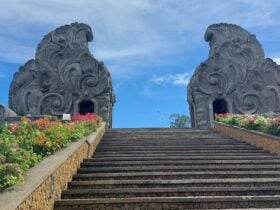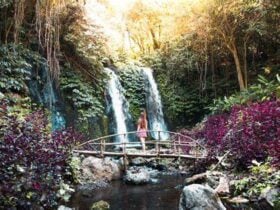Exploring the Don Antonio Blanco Museum

Exploring the Don Antonio Blanco Museum. Nestled on the lush hills of Ubud, the Don Antonio Blanco Museum is a unique destination that blends the worlds of art, Balinese culture, and tropical beauty. This museum, dedicated to the life and work of the late Don Antonio Blanco, one of Bali’s most celebrated artists, offers visitors a rare glimpse into the life of a visionary painter who found inspiration in Bali’s rich cultural landscape. Known for his bold and sensuous works, Blanco’s art reflects his deep passion for the island, its people, and its natural beauty. This article explores the history, architecture, art collections, and cultural significance of the Don Antonio Blanco Museum, making it an essential visit for art lovers and cultural enthusiasts alike.
1. Who Was Don Antonio Blanco?

Don Antonio Blanco, often referred to as the “Dali of Bali,” was a Spanish-American painter born in Manila, Philippines, in 1912. After spending his early years in various countries, Blanco’s artistic journey eventually led him to Bali in the 1950s, where he fell in love with the island’s beauty, vibrant culture, and spiritual atmosphere. Bali became his home, his muse, and the canvas upon which he would create his most famous works. His fascination with the female form, combined with his eclectic personality, led to a distinct style that blends surrealism with Balinese motifs, often depicting women in vibrant and expressive poses.
Blanco’s works often feature rich colors, flowing lines, and a touch of fantasy, creating an artistic universe that feels both sensual and mystical. His art was not just a personal endeavor but also a celebration of Bali’s cultural heritage, as he often incorporated traditional Balinese elements and themes into his paintings. Blanco’s home in Ubud, which he transformed into a museum, became a hub for artists, intellectuals, and cultural figures from around the world, solidifying his legacy as one of Bali’s most influential artists.
2. The Creation of the Don Antonio Blanco Museum
The Don Antonio Blanco Museum, or the Blanco Renaissance Museum, was established in 1998 as a tribute to Blanco’s life and work. Built on the artist’s private property, the museum was his former home and studio, overlooking the lush Campuhan Valley in Ubud. Designed to embody Blanco’s artistic style and unique personality, the museum is a fusion of Balinese architecture and Spanish influences, with flamboyant details and an air of grandeur.
Blanco’s family, especially his son, Mario Blanco, who is also an artist, played an instrumental role in preserving his father’s legacy and ensuring that his works are accessible to the public. The museum’s creation reflects the Blanco family’s commitment to honoring Antonio Blanco’s impact on Balinese art and culture. Today, the museum stands as a testament to Blanco’s life, housing a vast collection of his paintings, sketches, and personal artifacts, offering visitors a journey into his creative world.
3. Architecture and Layout of the Museum

The Don Antonio Blanco Museum is as much a work of art as the pieces it houses. The museum building itself reflects Blanco’s flamboyant style, with its Baroque-inspired architecture, bold decorations, and intricate carvings. The entrance gate, adorned with gold and colorful accents, features Blanco’s signature crest, showcasing a hand holding a brush – a fitting symbol of the artist’s dedication to his craft.
The museum is spread across several rooms and levels, each filled with paintings, sketches, and sculptures that capture Blanco’s artistic journey. The gardens surrounding the museum add to the sense of tranquility, with exotic plants, stone statues, and fountains that create a lush tropical setting. Blanco’s former studio, which has been preserved, provides a fascinating glimpse into the artist’s workspace, with brushes, easels, and unfinished works that offer a personal look into his creative process.
At the heart of the museum is a grand staircase leading to the main gallery, where Blanco’s most famous works are displayed. The interior spaces are decorated with ornate frames, chandeliers, and dramatic lighting that enhance the museum’s theatrical atmosphere, making the visit a multisensory experience. The design and layout of the museum reflect Blanco’s artistic vision, transporting visitors into a world of fantasy, beauty, and creativity.
4. Art Collections and Exhibitions
The Don Antonio Blanco Museum houses an extensive collection of Blanco’s works, spanning his entire career. His paintings, which primarily focus on the female form, are known for their bold colors, flowing lines, and intricate details. The themes in his works often revolve around beauty, love, sensuality, and femininity, which he depicted with both admiration and a sense of playful surrealism.
Blanco’s works are also influenced by Balinese culture and spirituality, often incorporating Hindu symbols, traditional Balinese dress, and tropical landscapes. Some of his most iconic paintings feature Balinese women adorned in elaborate costumes and jewelry, set against lush backgrounds that evoke the island’s natural beauty. His portraits are rich in emotion and expression, with each piece telling a story of its own.
In addition to his paintings, the museum also exhibits Blanco’s sketches, lithographs, and personal memorabilia. These items provide insight into his artistic process and creative inspirations, as well as his connections with other notable figures in the art world. The museum’s collection offers a comprehensive look at Blanco’s artistic evolution, from his early works to his more mature pieces, showcasing the depth and versatility of his style.
Special exhibitions are sometimes held at the museum, featuring works by Blanco’s son, Mario Blanco, as well as other contemporary artists who draw inspiration from his legacy. These exhibitions add a dynamic element to the museum, celebrating the continuing influence of the Blanco family on Balinese art.
5. The Cultural and Artistic Significance of the Museum

The Don Antonio Blanco Museum holds a special place in Bali’s cultural landscape. It serves not only as a museum but also as a cultural center that bridges the gap between Balinese and Western art traditions. Blanco’s work, which combines Western surrealism with Balinese motifs, represents a fusion of different cultural influences, highlighting the ways in which Bali has inspired artists from around the world.
The museum attracts art enthusiasts, tourists, and scholars who wish to understand Bali’s influence on international art and vice versa. Blanco’s approach to art, which emphasized self-expression and breaking boundaries, resonates with many visitors and has left a lasting impact on Bali’s artistic community. His art challenges traditional norms, encouraging artists to explore their own unique visions while remaining connected to their cultural roots.
Blanco’s role as a cultural ambassador is also evident in the museum’s dedication to preserving Balinese heritage. Through his art, he celebrated Balinese beauty and spirituality, capturing the essence of the island in a way that is both intimate and universal. His legacy continues to inspire young artists in Bali and beyond, fostering a sense of creativity that transcends cultural barriers.
6. Visitor Information and Tips
For those planning to visit the Don Antonio Blanco Museum, here are some practical tips to enhance your experience:
- Location: The museum is located on Jalan Raya Campuhan in Ubud, making it easily accessible from central Ubud. Its location near the Campuhan Ridge Walk allows visitors to combine both experiences for a day of art and nature.
- Opening Hours: The museum is open daily from 9:00 am to 5:00 pm. It’s best to arrive early to enjoy the galleries and gardens without large crowds.
- Admission Fee: There is an entrance fee to the museum, which includes access to all exhibitions and facilities. The fee supports the maintenance of the museum and its programs.
- Guided Tours: For those interested in learning more about Blanco’s life and work, guided tours are available. The knowledgeable staff can provide background information on the artwork, the history of the museum, and Blanco’s legacy.
- Photography: Photography is generally not allowed in certain parts of the museum, particularly in the main galleries. Check with museum staff before taking any pictures.
- Gardens and Cafe: The museum grounds feature beautifully landscaped gardens and a small café where visitors can relax and enjoy refreshments. The café offers a peaceful spot to reflect on the artwork while surrounded by tropical greenery.
7. Why the Don Antonio Blanco Museum is a Must-Visit in Bali
The Don Antonio Blanco Museum is more than just a collection of artworks; it is an experience that immerses visitors in the life, personality, and legacy of one of Bali’s most eccentric and influential artists. From the stunning architecture and lush gardens to the intimate look into Blanco’s artistic process, the museum offers a fascinating journey into a world of creativity and cultural fusion. It celebrates both Balinese heritage and the freedom of artistic expression, making it an ideal destination for anyone with a passion for art, culture, and history.
Visiting the Don Antonio Blanco Museum provides a deeper understanding of how Bali has influenced artists from all over the world and how they, in turn, have contributed to Bali’s cultural landscape. For art lovers, the museum is a treasure trove of visual delights, while for others, it offers a unique and memorable experience that captures the beauty and spirit of Bali.
The Don Antonio Blanco Museum is a testament to the artistic legacy of Antonio Blanco and his lasting impact on Balinese culture. Set against the backdrop of Ubud’s lush scenery, the museum invites visitors to explore an artistic world that is both bold and introspective, combining elements of Western surrealism with Balinese tradition. With its eclectic collection, beautiful surroundings, and rich cultural significance, the Don Antonio Blanco Museum is a must-visit destination for anyone seeking to experience the essence of Bali through the eyes of a true artist.










Leave a Review